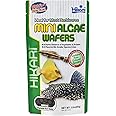When it comes to choosing the right food for your aquarium fish, the plethora of options can be daunting. Among these, Hikari Algae Wafers have gained recognition for their quality and effectiveness in promoting the health of bottom-feeding fish. This article will delve into a comprehensive comparison between Hikari Algae Wafers and other popular fish food options, such as flakes, pellets, and freeze-dried foods. By exploring the benefits, ingredients, and suitability for various fish species, we aim to provide valuable insights that will help aquarists make informed decisions.
Understanding Hikari Algae Wafers
Hikari Algae Wafers are specially formulated food designed primarily for herbivorous fish and bottom feeders, such as catfish and plecos. They are packed with essential nutrients and algae, making them a popular choice among fish enthusiasts.
Key Ingredients

The primary ingredients in Hikari Algae Wafers include:
- Spirulina algae: A highly nutritious blue-green algae rich in proteins and vitamins.
- Wheat flour: A common binder that provides energy.
- Fish meal: A protein source that supports muscle development.
- Vitamins and minerals: Essential for overall health and disease resistance.
This combination of ingredients not only caters to the nutritional needs of herbivorous fish but also ensures they receive a balanced diet.
The Case for Algae Wafers

Hikari Algae Wafers come with several advantages that set them apart from other fish food options. Here are some noteworthy benefits:
- Convenience: Wafers sink slowly, allowing bottom feeders to access food easily.
- Digestibility: The formula is designed to be easily digestible, reducing waste and improving water quality.
- Variety of Fish: Suitable for various species, including catfish, plecos, and even some cichlids.
Comparing with Other Fish Food Options
![Hikari Tropical Algae Wafers Fish Food [Set of 2] Size 8.](https://m.media-amazon.com/images/I/519qgeD+2pL._AC_.jpg)
To better understand the standing of Hikari Algae Wafers, we will compare them with three other popular fish food types: flakes, pellets, and freeze-dried foods.
1. Flake Food

Flake food is one of the most common types of fish food. It consists of thin layers of fish meal and other ingredients that are dried and processed into flakes.
Advantages of Flake Food
- Wide Variety: Flake food is available for almost all types of fish, including herbivores, carnivores, and omnivores.
- Easy to Feed: The flakes float on the water’s surface, making them easy for fish to consume.
Disadvantages of Flake Food
- Potential for Waste: Flakes can create waste if not consumed quickly, leading to water quality issues.
- Nutritional Gaps: Some flakes may lack specific nutrients essential for fish health.
While flake food is convenient, it may not be the best option for bottom feeders who require food that sinks, like Hikari Algae Wafers.
2. Pellets
Pellets are another popular option and are available in various sizes and formulations to suit different fish types.
Advantages of Pellets
- Controlled Feeding: Pellets sink at different rates, allowing for targeted feeding.
- Nutritional Value: High-quality pellets are often rich in proteins and vitamins, similar to Hikari Algae Wafers.
Disadvantages of Pellets
- Size Limitations: Some pellets may be too large for smaller fish species.
- Cost: High-quality pellets can be more expensive than other options.
Hikari Algae Wafers hold an advantage over pellets when it comes to catering specifically to herbivorous bottom feeders.
3. Freeze-Dried Foods

Freeze-dried foods, such as bloodworms and brine shrimp, are popular among aquarists for their high protein content.
Advantages of Freeze-Dried Foods
- Flavor: Many fish find freeze-dried foods irresistible, enhancing feeding response.
- High Protein: Excellent for carnivorous fish and promoting growth.
Disadvantages of Freeze-Dried Foods
- Limited Nutritional Profile: Often lacks complete nutrition, requiring supplementation.
- Water Quality: Can lead to increased waste if not consumed completely.
While freeze-dried foods are excellent for protein-loving fish, they do not provide the balanced nutrition that Hikari Algae Wafers offer to herbivorous species.
Case Studies
To exemplify the efficacy of Hikari Algae Wafers, consider two case studies involving aquarists who switched to this food option.
Case Study 1: Home Aquarium with Plecos
A hobbyist switched to Hikari Algae Wafers for their aquarium housing several plecos. Previously using flake food, they noticed that the plecos often went hungry as the flakes floated and were consumed quickly by other fish. After introducing Hikari Algae Wafers, the plecos thrived, showing improved growth and coloration. The hobbyist reported less waste in the tank, as the wafers were consumed more efficiently.
Case Study 2: Community Tank with Various Species

In a community tank containing both herbivorous and carnivorous species, an aquarist began using Hikari Algae Wafers as a staple food. They observed that the bottom feeders were healthier and more active. Moreover, the carnivorous fish also showed interest in the wafers, leading to a more balanced diet for all species. The overall health of the tank improved, with clearer water quality and reduced algae growth.
In summary, Hikari Algae Wafers stand out as a superior choice for feeding herbivorous and bottom-feeding fish compared to other options like flakes, pellets, and freeze-dried foods. Their balanced nutritional profile, ease of use, and digestibility make them particularly effective for promoting fish health and maintaining water quality in aquariums. While other fish food options have their merits, for aquarists looking to cater specifically to the dietary needs of algae-eating fish, Hikari Algae Wafers prove to be a worthwhile investment. By understanding the strengths and weaknesses of each food type, hobbyists can create a diverse and nutritious feeding regimen that supports a thriving aquatic ecosystem.